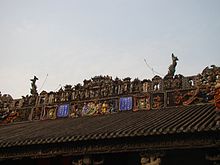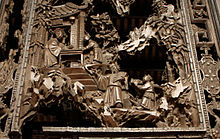- Chen Clan Academy
-
Glen Chan Academy 陈家祠 
EntranceEstablished 1894 Location Guangzhou, China Type Cultural The Chen Clan Academy (simplified Chinese: 陈家祠; traditional Chinese: 陳家祠; pinyin: Chén Jiā Cí) is an academic temple in Guangzhou (Canton), China built by the 72 Chen (It is usually romanised as Chan in Cantonese) clans for their juniors' accommodation and preparation for the imperial examinations in 1894 in Qing Dynasty.[1] Later it was changed to be the Chen Clan’s Industry College, and then middle schools afterward. Now it houses the Guangdong Folk Art Museum (广东民间工艺博物馆).
Located at Zhongshan 7th Road, the Chen Clan Academy is a symmetric complex consist of 19 buildings with nine halls and six courtyards. Facing south, the complex forms around a north-south axis.[2] A large collection of southern China art pieces, for example, wood carvings and pottery, can be found in the structure. The Chen Clan Academy complex exemplifies traditional Chinese architecture and decoration style, and has influenced cultural and architectural developments worldwide. It was added in the list of "Cultural Relics of National Importance under the Protection of the State" in 1988.
Contents
History
In late Qing Dynasty, Chen Ruinan and Chen Zhaonan, Chinese-Americans who returned to Guangzhou, purposed the idea to raise money from all the Chen clans to build a temple for the worship of their ancestors and a place for their clansman to study for the examination.[1] Therefore, the Glen Chan Academy was finished in 1894 with the money donated by Chen families in 72 counties of Guangdong Province as well as some overseas family members. When the imperial examination system was abolished in 1905, the Chen Clan Academy was changed into the practical school of the Chens. Later in 1957, the Guangzhou City People's Committee approved the Chen Clan's Academy as a Guangzhou City preserve. Then in 1959 the government introduced a folk arts and crafts gallery into the temple. Now it serves as the Guangdong Folk Art Museum.[3]
Structure
The Chen Clan Academy is a traditional Chinese academic complex covering 13200 square meter.[2][3] The complex consists of 19 buildings with nine halls and six courtyards which are connected by corridors and ride north to south in a symmetric pattern. On the main axis lie the Head-entrance (Chinese: 頭門), the Gathering Hall (Chinese: 聚賢堂) and the Back Hall (Chinese: 後堂). This three main buildings are separated with courtyards.[2]
The Head-entrance is 27.56 meter wide and 14.91 meter deep with 17 columns, all decorated with flowers and figures.[2][3] On the top of the gate of the Head-entrance hangs a tablet with words 陳氏書院, meaning "Glen Chan's Academy". On the sides of the gate sit stone mats and a pair of 2.25 meter high stone drums.[2] River Gods are painted in color on the gate. Inside the gate there are four double-side engraved screen. The main beams are decorated with birds, flowers, human figures plasters, bats and lions.
The Gathering Hall was once a place for meeting and worship of the Chen clansmen and now it is used as an ancestral hall. It is 27.84 meter wide and 16.7 meter deep with 21 main beams and 6 stone craved columns.[2][3] In front of the hall lies a stone gazebo surrounded by stone balustrades. Inside the hall sit twelve engraved folding screens. The pottery sculpture on the beams are renewed in 1981.
Memorial tablets of ancestors were placed on a 21-step wooden shelves in the Back Hall, which was once used for worship of ancestors. In the rooms sit 7-meter-high wooden-carved niche covers.
Buildings are separated with "Qingyun alleys" (Chinese: 青雲巷) and connected with corridors.
The buildings in the Chen Clan Academy are fully decorated with wood carving, stone carving, brick carving, pottery, plaster and iron engraving. The content of these decoration are mostly flowers, birds, Cantonese fruits and scenes in traditional dramas.[3]
Art works
The Chen clan academy is notable for the rich decoration which exist inside, outside the halls and in almost every beams, ridges, walls and columns. This make the Chen Clan Academy a large collection of wood carving, stone carving, brick carving, pottery, plaster and iron engraving.
Pottery
One of the most distinguished features of the Chen Clan Academy is the 11 pottery ridge crest, which was installed on the nine great halls of the academy. Each ridge crest has a theme taken from famous traditional dramas. Some are figures of characters in a play, some have series of more than ten scenes in a drama. With summering and exaggerating, the pottery ridge crests show the featured drama scene in comic series. The pottery ridge crest on the roof of the Gathering Hall has the largest scale and most delicate manufacture among all. This ridge crest spans 27 meter, 2.9 meter in height, 4.26 meter high with the plaster base and contains a total of 224 figures. The scenes in this ridge crest are "Celebrating the birth of gods", "Qilin giving people offspring", "The bearded man and Li Jing" and some others. Along with the figures are patterns of Yutang birds and peony, which represent wealth and glamour, and shapes of melons and fruits, which represent flourish of offspring. Moreover, the tip of the ridge crests are flying cods, which were believed to be a half-dragon half-fish creature. These flying cod figures have tentacles reaching out from the roof to the sky, which make the profile of the building more elegant.
Wood carving
The Chen clan academy has a large collection of wood carvings, which can be seen everywhere in the halls at the corners of the beams, walls, and doors. On the beams in the Head entrance sit eight pieces of exquisite wood carvings describing historical stories like "Tongque Tai (銅雀臺)", "Celebrating the birth of the God Mother (王母祝壽)" and "The alliance of Goujian, the king of Yue (越王勾踐會盟)".[4] The most prominent wood carvings work in Chen Clan Academy is the sixteen double-sided wood carving screen doors in the back of the Gathering Hall, each describing a classic drama scene in old story books like the Romance of the Three Kingdoms and The biography of Yue Fei.These wood carvings have abundant high resolution figures as each facial expression can be clearly distinguished. Also, wood carvings work from Guangdong can be found in the folk art and craft gallery.
Plaster carvings
The plaster carvings in the Chen Clan Academy lie mostly on the bases of ridges and the roofs of corridors and have a total length of 1800 meter in the temple.The theme of the plaster sculptures are similar to those of pottery crests: scenes in traditional dramas, birds and flowers, pavilions, and landscapes. Plaster in old Cantonese houses were called "grass tails" since the pattern are often shaped like curling grass and placed on the end of walls. In wealthy families, larger scaled and more delicate plaster were used in the house decorating. Since plaster has to made on site, artist can bring their talent to play according to the surrounding. The plaster carvings in the Chen Clan Academy were example of exquisite plaster art: some were made as they go through the wall; some come out up to 60 centimeter from the wall, giving a three-dimensional effect.
Brick carving
Brick carvings in the Chen Clan Academy lie on the inner walls of each great halls. The one on the east wall features the old story "Liu Qing taming 'the Wolf'", with more than 40 figures in the picture, describing the lively scene of the man Liu Qing taming the wild horse from the west named "the wolf" in the time of Northern Song. Each figure has a distinguished facial expression and pose.
Engraving
The iron engravings in the Chen Clan Academy are mainly used on the platform railings. These engravings have symmetric patterns and four different themes, which are "The Qilin and the Phoenix", "Dragons and orbs", "The three goats" and "Goldfish in a pond". The iron engravings railings are dim in color and delicate in structure. They are rarely seen in traditional Cantonese architecture.
References
- ^ a b Yang, Sen (1996). Dictionary of Guangdong Places of Interest (广东名胜古迹词典). Beijing: Beijing Yanshan Press.
- ^ a b c d e f Wu, Qingzhou (2000). Guangdong Architecture (广东建筑). Guangdong: Guangdong Map Press.
- ^ a b c d e LingNan Art Press (1990). Notes of Cultural Relic in Guangzhou city (广州市文物志). Guangdong: LingNan Art Press.
- ^ Feng, Bozhu (2000). Culture and Folk Art in Guangzhou (广东风物). Guangdong: Guangdong Map Press.
External links
Guangdong topics Guangzhou (capital) General Geography Cities • Pearl River mega-city • Leizhou Peninsula • Pearl River Delta • Northern Guangdong • East River • West River • Nanling Mountains • Pratas IslandsEducation Guangzhou Education • Shenzhen Education • Shenzhen University • Huizhou University • Guangdong Institute of Education • Guangzhou UniversityCulture Lingnan culture • Music • Guangdong music (genre) • Cantonese opera • Teochew people • Hakka people • Hailufeng dialectCuisine Cantonese cuisine • White boiled shrimp • Cantonese fried rice • Chinese steamed eggs • Beef chow fun • Chow mein • Char siu • Roasted suckling pig • Bird's nest soup • Seafood birdsnestVisitor attractions Danxia Mountain • Seven Star Crags • Dinghu Mountain • Xinfengjiang Reservoir • Zhongshan Park • Guangdong Provincial MuseumCoordinates: 23°7′47.13″N 113°14′25.8″E / 23.1297583°N 113.2405°E
Categories:- Buildings and structures in Guangzhou
- Education in Guangzhou
- Liwan District
- Museums in Guangdong
Wikimedia Foundation. 2010.





